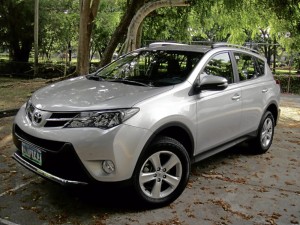Sport utility vehicles, including car-based ones, are usually more known for their practicality and spacious passenger and cargo room rather than smooth driveability. But when it comes to the 2013 Toyota RAV4, I would say that its most attractive quality, compared to other compact SUVs or crossovers, is its incredible smoothness.
By smoothness, I refer to almost every aspect of the new RAV4’s performance: the light effort in steering at slow speeds afforded by its electric power assist; the short, closely spaced ratios of its 6-speed automatic sequential transmission with an extra-tall top gear that allows relaxed, economical highway cruising; the way the Sport mode enlivens the steering and throttle response and holds gears longer when cruising or when negotiating inclines; how the top two cogs of the 6-speed A/T are overdrive gears that aid fuel efficiency; the more refined chassis with more roll stiffness and a lower center of gravity; plus handling that feels firmer and more planted than before.
All the above are much appreciated if you, like me, used to own and drive an earlier model RAV4. Although the first generation of a new car is often perceived as a work in progress that requires improvement and fine-tuning during its ensuing iterations, the 1996 RAV4, the original, was impressive enough for me. Back then, I bought a brand-new three-door 1996 4WD model powered by a 2-liter, 120-hp 4-cylinder gasoline engine (the Camry’s?) mated to a notchy 4-speed manual transmission. It wasn’t as smooth as the current RAV4 models, but it was funky and fun to drive.
REDESIGNED. This fourth-generation RAV4, model year 2013, was unveiled at the 2012 Los Angeles Auto Show, replacing the 7-year version (2006 to 2012). Completely redesigned from the ground up although built on the same wheelbase as the previous model’s, the new RAV4 is more mainstream than ever, with quite bland looks—despite the new, sharper fascia, lower-to-the ground stance—that would appeal more to young moms and retired empty-nest couples rather than the Y Generation.
In the United States and other markets, the RAV4 used to be offered with two engine options: the 2.5-liter, four-pot or a V6. Due to the V6 variant’s slow sales, Toyota made the 2013 RAV4 available with the 2.5-liter engine only and also removed the third-row seat option that increased seating from five to seven. Over here, the most noticeable difference between the previous model and the new one is that the side-hinged tailgate that swings open with spare tire mounted thereon has been replaced with a top-hinged liftgate with a space-saving spare
tucked under the cargo floor.
The new RAV4’s Dual VVT-i, 4-in-line, 16-valve twin cam engine produces 176 ps/ 6,000 rpm and 233 Nm/ 4,100 rpm max torque, same as before. What improves the RAV4’s driveability and fuel economy is the previously described 6-speed A/T that replaced the previous 4-speed A/T. The 2.5-liter four, with Toyota’s larger displacement four cylinders, starts with a thrum and settles into a hum once warm. While the RAV4’s engine won’t exactly exhilarate car buffs, it produces enough power and is snappier due to the additional gears.
POWER SPLIT. The top-of-the-line 4×4 RAV4 (P1.963 million) has an electromagnetic coupling system that enables up to a 50/50 power split front to rear when traction is required in mud, gravel or slippery situations. However, the RAV4 is not a hardcore off-road vehicle with low-range gearing. The default setting is 100/0 with all power to the front wheels, but when in Sport mode more torque is delivered to the rear wheels for a more responsive steering feel.
The suspension system (MacPherson strut in front and double wishbone at the rear) with coils and stabilizers fore and aft, enhanced spring rates and optimally tuned shock absorbers,
offers a more dynamic drive. The addition of more sound-deadening material contributes to a quiet, comfy, smooth ride and low levels of road noise on the expressway.
The most notable improvement in the RAV4 is the ergonomically friendly, slightly larger and refined cabin upgraded with natural leather seats, chrome accents, metal trim and soft padding in the 4X4 variant. The audio is a 6-speaker, 6.1-inch Integrated TFT Display with AM/FM/CD/MP3/AUX/USB/
iPod and Bluetooth function. Cruise control, wireless door lock with smart entry and push-start engine are standard in the 4X4. The rear seat splits 60/40 and folds down to increase cargo space to a class-leading 73.4 cubic feet. Moreover, the cargo area has a tonneau cover and net tray. The only thing missing is a reverse camera, instead there is a rear sonar.
SAFETY. To protect occupants, the 4X4 variant has two front SRS airbags, curtain shield and side airbags, ABS, disc brakes on all four 17-inch alloy wheels, LED high mount stop lamp, side impact beams—the usual active and passive safety features.
Summing up, the RAV4 has matured from an impish, fun-to-drive compact SUV into a sensible, utilitarian and mainstream family vehicle. It has a smoother, more carlike character than in the past. With a better transmission, fresh interior and retention of generous passenger and cargo space, the incredibly smooth fourth-generation RAV4 continues the brand’s forward progression.
No wonder over 1.7 million RAV4 units have been sold worldwide since its intro in 1996.
